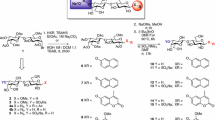Abstract
Protein (lectin)-carbohydrate (cellular glycoconjugate) recognition is operative in biochemical information transfer. Galectins constitute a family of endogenous galactoside-binding lectins with conserved features in the binding site. The members of this lectin category are assumed to be involved in cell adhesion and growth regulation. To assess to what extent the different modes of binding-site presentation and/or carbohydrate fine-specificities will affect aspects of galectin behavior, homodimeric cross-linking galectin-1 and monomeric chimeric galectin-3, with its collagenase-sensitive stalk linked to the carbohydrate-recognition domain, were investigated. Cell-surface expression of the two galectins and accessible galectin-binding sites on various tumor cell lines was ascertained by FACScan analysis. In particular, ligand accessibility for the two galectins differed for the tested cell line types. Binding of tumor cells to laminin and plasma or placental fibronectin was generally reduced by treatment of cells or matrix with galectins. Galectin-3 was more efficient than galectin 1 at impairing laminin's potency as matrix. Cell binding of galectin-1, on the other hand, proved on average more effective for blocking cell association to fibronectins after its preincubation with cell suspensions. Differences were also apparent in the biodistribution of the galectins, where an avian homolog of galectin-1 served as the control to distinguish effects of spatial and sugar-binding features. Histopathological analysis of lymph-node-negative and -positive breast and colorectal carcinomas (n = 180 including 60 metastatic lesions) indicated a correlation of either increased galectin-1 binding and reduced galectin-3 expression or reduced binding of both galectins with the occurrence of lymph node lesions. Together with data on the heparin-binding lectin, revealing reduced expression to be associated with a positive lymph-node status in the breast cancer group, these results can be interpreted to reflect cell-type-dependent requirements of galectin ligand presentation during the metastatic cascade. By introducing mammalian lectins to lectin-histochemical studies, the detection of quantitative differences in glycosylation brings an understanding of its cell biological significance one step closer.
Similar content being viewed by others
Author information
Authors and Affiliations
Additional information
Received: 4 March 1999 / Accepted: 31 March 1999
Rights and permissions
About this article
Cite this article
André, S., Kojima, S., Yamazaki, N. et al. Galectins-1 and -3 and their ligands in tumor biology . J Cancer Res Clin Oncol 125, 461–474 (1999). https://doi.org/10.1007/s004320050303
Issue Date:
DOI: https://doi.org/10.1007/s004320050303




